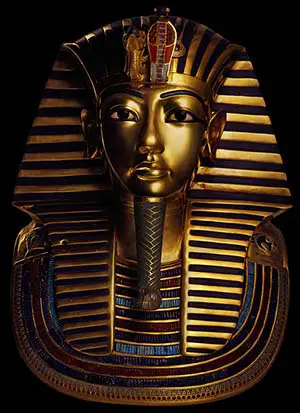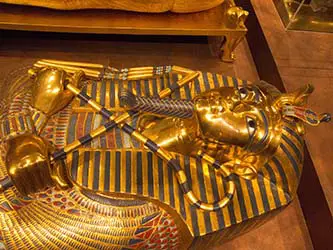King Tut's Mask
In November of 1922, an archaeologist by the name of Howard Carter made international news when he discovered the tomb of Tutankhamun, more commonly referred to as King Tut. Excavations of the tomb lasted for nearly ten years due to the massive amount of treasures that were held within. It was almost exactly three years later in October of 1925 when the sarcophagus of King Tut was opened and the famous mask of King Tut was revealed.
Purpose
The beautiful and intricate mask of King Tut was designed in the image of the pharaoh and was intended to assist the king's spirit in its transition to the afterlife. In addition to ensuring that the soul was able to recognize its own body, the burial mask transformed mortals to a godly state and allowed them to pass safely through the underworld.

© Ars Electronica - King Tut's Burial Mask
Description
King Tut's mask weighs about 25 pounds and stands about 2 feet tall. This priceless treasure is composed of a solid gold base inlaid with semi-precious stones such as lapis lazuli, obsidian, and quartz.
The face of the mask, meant to be a likeness of King Tut, is made of a smooth, radiant gold. Ancient Egyptians associated gold with the sun god, Ra, and considered it to be a powerful material for aiding pharaohs in their journey to the afterlife.
Sitting atop the pharaoh's head is a traditional headpiece made of gold with bright blue stripes of lapis lazuli. In addition to the striking blue stripes, the headpiece features both a rearing cobra and a vulture. Known together as the “two ladies of the pharaoh”, these figures would have served a dual purpose of protecting the pharaoh from those who might oppose him and symbolize the king's power over both Upper and Lower Egypt.
Notable rings of lapis lazuli encircle the eyes of King Tut's mask. Elaborate eye makeup was a standard for Egyptian royalty, as it created the almond eye shape which was considered desirable. One of the most notable features of King Tut's mask is the long, narrow golden beard. False beards similar to the one on the mask would have been worn by the pharaoh as a symbol of his position as a living god and divine being.
Coupled with the false beard, the crook and flail crossed over the chest would have emphasized the relationship between Osiris, lord of the underworld, and the spirit of the deceased pharaoh. Spells for protection and guidance from the ancient Egyptian Book of the Dead are carved into the back and shoulders.

© Thomas Quine - Mask with Crook and Flail
Cairo Museum
Since its discovery, the mask of King Tut has primarily resided in the Egyptian National Museum in Cairo, Egypt. However, it has traveled throughout the United States and Europe many times over the last fifty years. For the time being, the mask is at rest in Cairo and no further tours are planned.
Interesting Facts
- 8 employees of the Egyptian National Museum are being sued for mishandling King Tut's mask after it was discovered that the braided beard had been broken off and reattached improperly.
- The mask's beard weighs over 5 pounds by itself.
- Some archaeologists argue that the mask was not made for King Tut, but rather for Queen Nefertiti. The piece features pierced ears, typically reserved for women, and a cartouche that appears to have been filed down and retouched.
- Revenue from the mask's last visit to the United States topped $10 million and allowed the Egyptian National Museum to completely refurbish its facilities.
- The spell carved into the back of the mask comes from chapter 151 of the Book of the Dead. This spell provides a road map to the afterlife and protects the pharaoh's limbs as he moved through the underworld.

